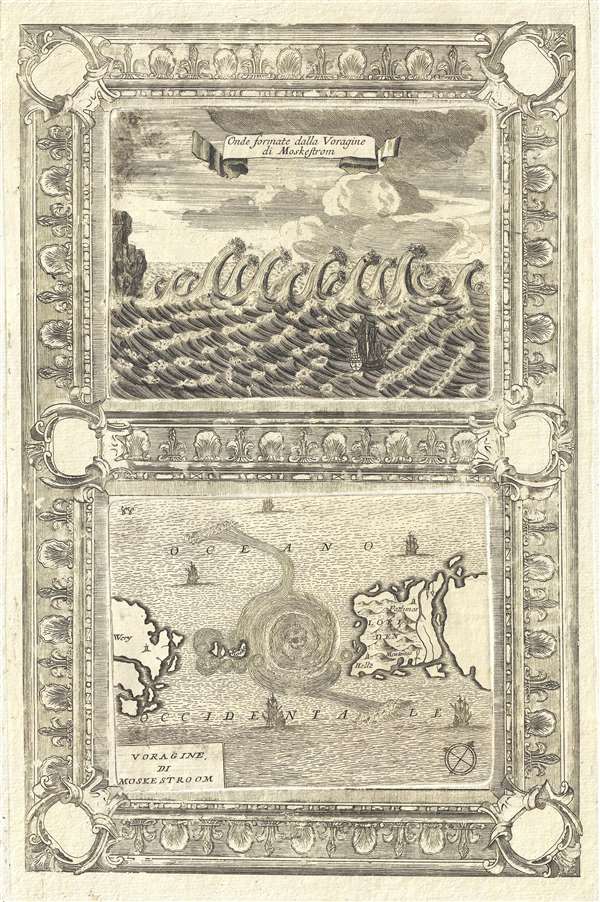This item has been sold, but you can get on the Waitlist to be notified if another example becomes available, or purchase a digital scan.
1690 Coronelli Map and Illustration of the Loften Maelstrom (whirlpool)
VoragineDiMoskestroom-coroneli-1690
Title
1690 (undated) 16 x 10.5 in (40.64 x 26.67 cm)
Description
a circle of more than a mile in diameter. The edge of the whirl was represented by a broad belt of gleaming spray ; but no particle of this slipped into the mouth of the terrific funnel, whose interior, as far as the eye could fathom it, was a smooth, shining, and jet-black wall of water, inclined to the horizon at an angle of some forty-five degrees, speeding dizzily round and round with a swaying and sweltering motion, and sending forth to the winds an appalling voice, half shriek, half roar, such as not even the mighty cataract of Niagara ever lifts up in its agony to Heaven.The present offering is one of the finest cartographic representations of the Lofoten Maelstrom ever published. Tipped into Coronelli's Isolario dell' Atlante Veneto, considered among the greatest atlases ever published, the Maelstrom is considered both in map form and as seen from a ship at sea. The illustrations are in fact more akin to Poe's fictionalized account than any factual representation of the maelstrom. The upper image shows great wave, of such magnitude that they dwarf the tall ship sailing towards them. The lower image shoes the Maelstrom from above, illustrating the ocean currents taking on the form of a massive singular whirlpool. The image is framed by a dramatic fleur-de-lis and scallop shell surround.
This map and view accompanied the Isolario, volume 2 of Coronelli's Atlante Veneto. The Isolario, was a comprehensive survey of the world's great islands along with phenomenological diagrams of weather patterns, instruments, ships, fortresses, and nautical oddities. All maps from Coronelli's Atlante Veneto have now become uncommon on the market.
Cartographer
Vincenzo Maria Coronelli (August 16, 1650 - December 9, 1718) was an important 17th-century cartographer and globe maker based in Venice. Coronelli was born the fifth child of a Venetian tailor. Unlikely to inherit his father's business, he instead apprenticed in Ravenna to a woodcut artist. Around 1663, Coronelli joined the Franciscan Order and, in 1671, entered the Venetian convent of Saint Maria Gloriosa dei Frari. Coronelli excelled in the fields of cosmography, mathematics, and geography. Although his works include the phenomenal Atlante Veneto and Corso Geografico, Coronelli is best known for his globes. In 1678, Coronelli was commissioned to make his first major globes by Ranuccio II Farnese, Duke of Parma. Each superbly engraved globe was five feet in diameter. Louis IV of France, having heard of the magnificent Parma globes, invited Coronelli to Paris, where from 1681-83 he constructed an even more impressive pair of globes measuring over 12 feet in diameter and weighing 2 tons each. The globes earned him the patronage of Louis XIV and privileged access to French cartographic information from Jesuit sources in the New World, particularly Louisiana. Coronelli returned to Venice and continued to publish globes, maps, and atlases, which were admired all over Europe for their beauty, accuracy, and detail. He had a particular fascination for the Great Lakes region, and his early maps of this area were unsurpassed in accuracy for nearly 100 years after their initial publication. He is also well known for his groundbreaking publication of the first accurate map depicting the sources of the Blue Nile. At the height of his career, Coronelli founded the world's first geographical society, the Accademia Cosmografica degli Argonauti, and was awarded the official title Cosmographer of the Republic of Venice. In 1699, in recognition of his extraordinary accomplishment and scholarship, Coronelli was also appointed Father General of the Franciscan Order. The great cartographer and globe maker died in Venice at the age of 68. His extraordinary globes can be seen today at the Bibliothèque Nationale François Mitterrand in Paris, Biblioteca Marciana in Venice, the National Library of Austria, the Globe Museum in Vienna, the Library of Stift Melk, the Special Collections Library of Texas Tech University, as well as lesser works in Trier, Prague, London, and Washington D.C. Coronelli's work is notable for its distinctive style, which is characterized by the high-quality white paper, dark intense impressions, detailed renderings of topographical features in profile, and numerous cartographic innovations. More by this mapmaker...

